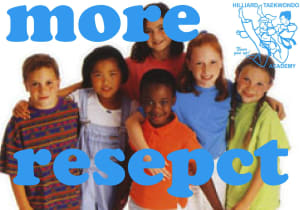
"How do you get kids to behave so quickly!?!"
This is one of the most frequent questions/comments we get from parents when their child tries a class at Hilliard Taekwondo Academy.
It's really not magic, and our strategies will work for you at home ... yes, really!
First, we understand:
- kids really do want to please us
- boundaries make kids feel safer
- we get more of the behavior we focus on most
Second, we are consistent in terms of:
- expectations
- recognition
- consequences
Third:
- planning ahead helps avoid reacting based on emotions, especially anger
- consequences tend to be more fair when applied based on a rule that's broken rather than how we feel in that moment
- recognition tends to be more fair when based on each person's effort rather than just on ability
- when there is a problem between two kids, make sure all those involved in creating the problem have appropriate consequences
Most importantly:
- if children are not used to consistent consequences/boundaries, their behavior typically gets worse at first
- if the child apologizes (typically hoping to avoid the consequence) the consequence still stands
*they SHOULD apologize, but an apology does not erase the behavior they chose to do
*the sincerity of the apology is revealed when the consequence still stands
- if a child gets angrier and has a temper tantrum because of a consequence, the consequence is reiterated calmly and they are told calmly if the temper tantrum continues (additional consequence appropriate for the behavior and the age) will also be applied ... and then apply it.
In our program, when students first try class or if we have a group come in for a special event, we explain the behavior we expect and what the consequences are for not following our rules.
As we start activities, there is typically a "class clown" who is used to grabbing the attention by being silly. We simply say a quiet "we don't do that here" and then we immediately give praise and focus to a student who is behaving respectfully, "Suzie, thank you for sitting so quietly with your hands on your knees. That's exactly what I'm looking for today!" We move to the next activity, and if the "class clown" does anything even remotely respectful, we praise that publicly. That child learns quickly that in our program it's not their silly behavior that will get them attention, but behaving with respect.
We want students to answer up confidently with "yes, ma'am!" and "yes, sir!" At the first hesitant "yes, ma'am" we give them recognition. As each student starts answering up, because they want the recognition too, we acknowledge each child ... at first. Then we acknowledge only the first student to answer up quickly, loudly and respectfully. Then we acknowledge the whole group for answering up.
That pattern continues.
With performance, we recognize effort.
If two students are doing the same kick, student A's kick may not look as good as student B's, but student A may be working really hard and giving great effort while student B may be giving very little effort at all.
"Student A, great effort! Your kick is getting better and better! Keep up the hard work!"
"Student B, nice kick. Let's see if you can kick even higher."
If a student is behaving in a way we don't want, and if it requires more than a verbal reminder, the consequences need to be appropriate for the behavior and the age of the student.
We don't count to three or keep saying over and over "if you do that again ..." or yell.
We typically start with a quiet, calm "we don't do that here."
The next time it may be "remember, we don't do that here, and if you do this again (we state the consequence, which may be sitting out a fun activity, can't test for a skill stripe today, will need to go home immediately ... it depends on the severity of the behavior and the age of the student)
If the student misbehaves again, the consequence is applied, without emotion on our part.
If the student apologizes, we thank them for apologizing and the consequence still is applied (apologizing doesn't erase what happened, it just shows us they recognize that what they did was not appropriate).
No matter what the student's response is, the consequence is still applied and if necessary they are reminded that we explained what was expected and what the consequence would be, and that it's important that they know we keep our promises and do what we say we will do.
We do not express irritation or frustration or anger with words or facial expression.
We simply and calmly remind students of the expectations and the consequences; look for opportunities to recognize the behavior we want, give very little attention to the behavior we don't want, and calmly but consistently apply the consequences when needed.
When the problem is siblings having a disagreement, we talk to them individually. We often find this is a pattern of behavior stemming from home with the younger sibling pushing older siblings buttons until the older sibling finally retaliates. Once the older sibling retaliates the younger sibling cries or screams and/or runs to mom and dad. Older sibling is lectured and punished. Younger sibling created the exact scenario they wanted, and even though they may have gotten hit by the older sibling to make it happen they won ... they got their older sibling in trouble.
As soon as we recognize the younger sibling instigating to get older sibling in trouble, we set consequences for both. The younger sibling needs consequences for starting the incident. The older sibling needs consequences or rewards for how they choose to respond. When the older sibling sees you are willing to be fair, that you recognize the role the younger sibling is playing in this problem, and that there are consequences for that younger sibling, the older sibling tends to be willing to work on making better choices for how to respond.
Again, we find the best tools for helping kids make better behavior choices are:
- planning ahead rather than trying to think up consequences on the spur of the moment
(are you REALLY going to cancel the Disney trip if they leave their shoes on the steps again?)
- preparing kids in advance with expectations and consequences
(the older the kids, the more involved they can be in helping to create a plan for expectations/consequences/rewards)
- praise the behavior you want
- apply immediate, age appropriate & situation appropriate consequences
- stay calm and stick to your rules
Parenting is hard work and like most things in life, the harder we work in the early stages to set the groundwork and overcome problems, the less effort is required later on.

